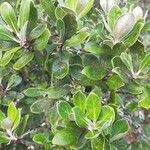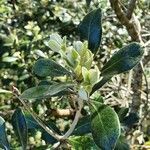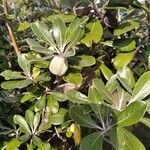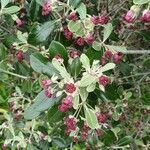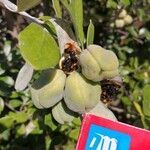Shrub or tree up to 9 m. tall, bark dark brown; branches erect to ascending, sts almost fastigiate; branchlets, lvs below, petioles and peduncles densely clad in white to buff subappressed tomentum (sts ferruginous in aged herbarium specimens). Lvs alt., very coriac., lamina 5-7-(10) × 2-2.5 cm., on stout petioles up to 2 cm. long, obovate-cuneate to obovate-elliptic to narrow-obovate, margins revolute. Fls functionally unisexual, in terminal umbels of 5-10 ♂ or 1-2 ♀. Sepals subulate to oblong-lanceolate, tapering, tomentose, c. 6 mm. long, petals narrow-oblong, c. 1 cm. long, dark red. Capsules subglobose to ovoid, tomentose, 2-3 cm. long, on stout decurved peduncles up to 1·5 cm. long; valves 3 or rarely 4, thick, woody.
Cultivated tree, 1-4 m high. Leaves coriaceous, obovate, base acute, apex broadly acute to rounded, margins revolute; petioles up to 10 mm long. Flowers wine-red. Fruit dark brown, larger than that of indigenous species.
